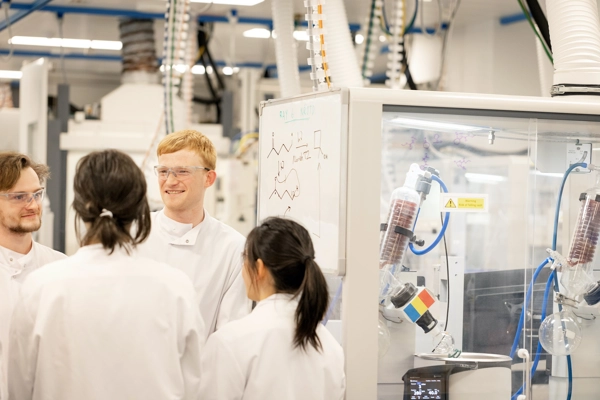Introduction
Breast cancer remains a global health challenge, with over 2.3 million new cases diagnosed annually, underscoring the need for effective early detection and accurate diagnosis methods.1,2 Traditional screening methods, such as…

Breast cancer remains a global health challenge, with over 2.3 million new cases diagnosed annually, underscoring the need for effective early detection and accurate diagnosis methods.1,2 Traditional screening methods, such as…

How do mammals manage to eat in situations that cause anxiety, step into exposed spaces, or slow down when anxiety drives them to keep moving? A new study pinpoints a leptin-sensitive circuit in the lateral hypothalamus that helps…

Student enjoyment pertains to the sense of pleasure or satisfaction that students derive from the learning process. Enjoyment of a learning activity fosters sustained motivation, enthusiasm, and positive emotions that enhance the overall learning experience.1,2 This aspect of education is closely intertwined with both student interest and motivation. While these three concepts share connections, they represent distinct dimensions of a student’s engagement with learning. Student interest involves the curiosity and attraction that they feel toward a particular subject or activity, whereas motivation encompasses the factors that drive students to dedicate themselves to the learning process.3 According to the Self-Determination Theory, motivation is enhanced when learners experience autonomy in learning, feeling of competence, and sense of relatedness to other students.4 Similarly, constructivist theory emphasizes that learning is most engaging when students actively construct knowledge through hands-on activities, real-world problem-solving, and collaborative interaction.5 This indicates that motivation is dependent on multiple factors that include the learner’s psychological needs, personal values, and the social context in which learning occurs. The synergy of enjoyment, interest, and motivation is crucial for the academic achievement of students, as these elements significantly influence student engagement with the overall learning experience.2–7 This combination contributes to a positive and effective learning atmosphere, fostering not only academic success but also a genuine passion for knowledge.4,8 While these concepts may overlap, each would play a distinctive role in shaping and enhancing the overall quality of the student’s learning experience.
Given the close relationship between motivation and positive learning experiences, student enjoyment can be seen as a complementary driver of engagement, influenced by factors such as teachers’ proficiency, students’ self-efficacy, and the complexity of the subject matter. This perception drives the ongoing search for more engaging and effective instructional formats, highlighting the need to explore and refine pedagogical strategies that address diverse learning needs. Within this context, lectures remain one of the most scrutinized instructional methods in higher education. Over the past decades, the debate about the effectiveness of didactical lectures has persisted, yielding mixed outcomes that reflect the diverse perspectives among educators and the heterogeneous opinions held by students regarding instructional methods.9–11 Didactic lectures have often faced criticism for their perceived lack of student enjoyment, primarily stemming from their reliance on passive one-way information delivery.12–14 In contrast to active learning methodologies such as problem-based learning (PBL) or team-based learning (TBL), students frequently perceive didactic lectures as boring or ineffective.12–14 In response to these critiques, many educators are adopting a more interactive approach to their lectures. They seek to engage students by incorporating entertaining activities such as real-life scenarios15 games16 technology17 or problem-solving components18 during lectures. However, despite these efforts, there are no universally clear guidelines on how to organize lectures that are not only educational but also enjoyable. Practical tips and useful recommendations published in Medical Teacher offer valuable strategies to help educators transform didactic lectures into interactive, and effective sessions.19
A skilled lecturer possesses the ability to attract the attention of students and enhance their enjoyment through various innovative techniques that include incorporating personal experiences, telling jokes, and sharing relevant stories.2,20 The impact of such engaging teaching strategies extends beyond mere enjoyment; they have the potential to significantly influence the overall motivation and performance of students. An instructor with an entertaining and effective teaching style can successfully convey information, fostering a positive and dynamic learning environment that may surpass the positive ratings of active learning.21 In contrast, some instructors may lack the talent to effectively engage and motivate their students, resulting in a potential adverse effect on the students’ overall academic performance. However, it is worth noting that Deslauriers et al demonstrated that while students may rate enjoyable lectures positively and even feel they learned more compared to active learning sessions, objective measures showed that actual learning was greater in active learning environments that were perceived lower, indicating that high enjoyment does not necessarily lead to better learning.22
The ongoing debate about the effectiveness of teacher-based learning methods (or passive instruction) versus student-based learning methods (or active instruction) is persistent despite the numerous studies conducted over the past decades. The multitude of factors influencing students’ enjoyment in both types of instruction could be responsible for the variable preferences or mixed feelings of enjoyment among students. In addition to the educational environment, factors such as teachers’ varying skills and experiences and the difficulty level of certain subjects all contribute to and impact the level of enjoyment experienced during a teaching activity.1,13,14,22 Since enjoyment influences engagement, the present study aimed to develop and validate an objective instrument for systematically measuring students’ enjoyment in different pedagogical contexts, and to apply it in evaluating the enjoyment of first-year students in Physiology lectures. This kind of tool would help teachers to examine teaching strategies, identify the origins of differences in student enjoyment, and understand how the same strategies will yield different results when used by different teachers or when applied to different contexts. We sought to apply this scale objectively to measure the enjoyment scores of didactic lectures and investigate associated factors. Through this research, we aim to contribute valuable insights into the dynamics of student enjoyment, offering a tool that explores the factors that influence students’ learning experiences.
In this cross-sectional study, we assessed the enjoyment levels of first-year undergraduate medical and dental students during two physiology lectures. Lectures were delivered by experienced and highly rated professor, followed a didactic format with interactive discussion to encourage student participation and lasted 50 minutes. First-year medical and dental students were chosen to participate in this study because they were newcomers to university health profession education, suggesting that they were unlikely to have developed preferences for specific instructional methods at this early stage. The University Research Ethics Committee granted approval for the study under the reference number “HEC-10-2023/24-F-M.” Informed consent was obtained by first providing students with a briefing sheet detailing the study’s aims and purpose. Students were informed that their participation was entirely voluntary and would not affect their marks or academic evaluation. They were then asked to sign a consent form confirming that they had read and understood the information and agreed to participate in the study. A total of 112 (68%) students participated in the study, with 32 (out of 47) participants from the dental college and 80 (out of 118) from the medical college. The measuring instrument was distributed to all students immediately following the teaching session.
The Learning Enjoyment Scale (LES) was developed by the investigators as a comprehensive and objective measure of students’ enjoyment in the learning process (Figure 1). A brief description of the scale with guidance on its analysis, has been previously published as a data note.23,24 The scale items are strategically based on the major categories of Bloom’s Taxonomy, specifically focusing on cognitive knowledge and affective attitudes. The LES comprises six items: knowledge, comprehension, application, analysis, concentration, and enjoyment. Students are requested to assess each item using a five-point Likert scale, ranging from 1 to 5 (1 = strongly disagree, 2 = disagree, 3 = unsure, 4 = agree, and 5 = strongly agree). The minimum and maximum total scores across the six items are 6 and 30, respectively. If all responses are agree (ie, Likert scale 4), the total score is 24, representing 80% of the maximum score. Conversely, if all responses are unsure (ie, Likert scale 3), the total score is 18, which accounts for 60% of the maximum score. Consequently, an excellent score is deemed to be above 80% (25–30), an acceptable score falls within the range of 60–80% (18–24), and a low score is defined as less than 60% (< 18). These thresholds facilitate clear interpretation of students’ enjoyment levels and are consistent with educational standards for assessing performance and satisfaction in academic settings.
|
Figure 1 The Learning Enjoyment Scale. The Learning Enjoyment Scale (LES) is a comprehensive tool developed to assess student enjoyment. (A) contains six items measuring perceived learning, confidence, interest, and overall enjoyment. (B) contains six items assessing factors influencing enjoyment, such as teacher talent, content difficulty, participation, achievement of objectives, stress levels, and skill satisfaction.
|
The second section of the scale (enjoyment attributes) assesses the influence of various factors on students’ enjoyment. These factors include the teacher’s talent, the complexity of the topic, student participation, fulfillment of objectives, perceived stress levels, and the development of skills. The analysis of this section provides detailed understanding of the specific elements that impact students’ enjoyment during the learning process.
The statistical analysis for this study was carried out using the Statistical Package for Social Sciences (SPSS), version 26. Reliability analysis was applied to determine the internal consistency of the Learning Enjoyment Scale (LES) through Cronbach’s alpha. The obtained value of Cronbach’s alpha was interpreted, with values greater than 0.7 indicating a good level of internal consistency. General tendencies of the Learning Enjoyment Scale items were analyzed using the mean ± SD. The comparisons and associations between LES items or LES attributes and the total score categories were analyzed using the Spearman correlation and the chi-square test with Fisher’s exact correction, as appropriate. A p-value of <0.05 was considered statistically significant.
Table 1 displays the items of the Learning Enjoyment Scale (LES), the learning domain assessed by each item and the general tendency of students to respond to each item. According to the Likert scale analysis, the overall tendency of students’ responses in this study was “agree”. Reliability and validity of the scale were confirmed in this study: internal consistency was excellent, with a Cronbach’s Alpha of 0.91. Exploratory Factor Analysis (EFA) supported the theoretical six-domain structure, with the first two components explaining 80.5% of the variance. Inter-item correlations ranged from 0.57 to 0.81, indicating meaningful relationships between items. These psychometric properties demonstrate that the LES is a robust and valid instrument for measuring students’ enjoyment in learning contexts.
 |
Table 1 General Tendencies of Students’ Responses to the Learning Enjoyment Scale Items
|
Table 2 shows the relationships of the six items of the LES with the three categories of the total score (Low, Acceptable and Excellent). The table shows a significant relation between the students’ responses and the LES categories, with “agree” being the most frequent response and “acceptable” being the major LES category.
 |
Table 2 Examining Students’ Responses to Learning Enjoyment Scale Questionnaire Items in Relation to Total Score Categories
|
Table 3 displays the association between enjoyment attributes and the three categories of the total score. Enjoyment of a learning activity was strongly related to teachers’ talent (P< 0.001), difficulty of the topic (P< 0.001), students’ active participation during the activity (P< 0.001), fulfillment of the objectives (P< 0.001), low level of stress during the activity (P< 0.001) and self-perception of acquired skills (P< 0.001).
 |
Table 3 Relationships Between Enjoyment Attributes and Categories According to the Total Learning Enjoyment Scale
|
Most dental students (97%) and medical students (95%) showed either acceptable or high enjoyment scores for the Physiology lectures. The difference between students in the two colleges was not statistically significant (Table 4).
 |
Table 4 Comparison of the Total Learning Enjoyment Scale Scores of Dental and Medical Students
|
Table 5 demonstrates moderate to strong positive Spearman correlations (ρ = 0.35–0.57) between the Total LES Score and all enjoyment attributes, indicating that students with higher LES scores consistently reported more favorable perceptions. The strongest association was observed for “The teacher is talented in teaching” (ρ = 0.57, p < 0.001), suggesting that perceptions of teaching talent are closely aligned with overall enjoyment levels. Other positive correlations further indicate that attributes such as active participation, fulfillment of learning objectives, reduced stress, satisfaction with skills gained, and perceived easiness of topic content also contribute meaningfully to students’ enjoyment.
 |
Table 5 Spearman Correlation Between Total Learning Enjoyment Score and Enjoyment Attributes
|
Enjoyment can be defined as a positive emotional response to learning experiences, characterized by interest, engagement, and satisfaction, which can coexist with the pursuit of academic excellence.25 Because it is a subjective feeling, there is currently no universally accepted instrument for its assessment. Researchers have employed a variety of approaches, including single-question ratings (eg, on a scale from 0 to 6),26 satisfaction questionnaires with open-ended items,27,28 adapted items from the Achievement Emotions Questionnaire,29 and researcher-designed questionnaires based on enjoyment indicators.30 While these methods provide useful insights, they vary widely in scope, depth, and focus, highlighting the need for a more structured and comprehensive tool that captures multiple dimensions of enjoyment and links them to specific aspects of the learning experience.
The Learning Enjoyment Scale (LES) employed in this study was developed by researchers to directly measure students’ enjoyment following various types of teaching activities. In developing this scale, a direct question about enjoyment was incorporated, alongside additional items assessing students’ perceptions of various learning domains (knowledge, comprehension, application, and analysis) which are recognized to influence enjoyment. The scale reflects students’ satisfaction and self-perception of the knowledge acquired during the completed teaching activity. The psychometric properties, including excellent internal consistency (Cronbach’s Alpha = 0.91), strong inter-item correlations (ranging from 0.57 to 0.81), and support for the theoretical six-domain structure through Exploratory Factor Analysis (explaining 80.5% of the variance), confirm that the LES is a reliable and valid tool for measuring students’ enjoyment in learning contexts. A test–retest reliability is planned for future research to further validate the scale. The LES items are grounded in the major categories of Bloom’s Taxonomy, encompassing cognitive knowledge and affective attitude, while the psychomotor domain is partially addressed in the second section of the scale. Broadly, the scale evaluates students’ perceptions of knowledge, comprehension, application, analysis, interest, and enjoyment attained during the teaching activity. The calculated total LES provides a quantitative value for comparisons across different teaching activities and is categorized as excellent, acceptable, or low. Our findings revealed a significant relationship between students’ responses to the questionnaire items and LES score categories, with “Agree” emerging as the most frequent response and “Acceptable” being the predominant category.
The second section of the LES is excluded from the score calculation but plays a crucial role in assessing specific factors known to influence the overall enjoyment score. This section evaluates key elements impacting enjoyment, including the teacher’s proficiency, the complexity of the topic, active student participation, alignment with learning objectives, perceived stress during the teaching activity, and skill development. Our study demonstrated a significant association between these enjoyment attributes and the total LES score for Physiology lectures. The findings affirm that these factors collectively contribute to the study’s acceptable LES score. Notably, didactic lectures are well received by students when these factors are effectively considered and addressed. It is essential to highlight that these factors, such as teachers’ talent and skills in teaching, are often overlooked in comparisons of teaching methods’ effectiveness, including a large number of studies that praise problem-based learning and team-based learning pedagogy for being superior to lectures in many educational aspects, including enjoyment.12–14 It is obvious that lectures can be engaging and enjoyable when presented by a talented faculty member and, conversely, uninteresting and ineffective when delivered by a faculty member lacking in presentation skills.
It is not surprising that the conclusion asserting that lectures are old teaching methods focused solely on simple transfer of information to passive listeners has been controversial for decades, as it overlooks the outcomes of interesting lectures delivered by expert talented professors who know how to draw the attention of their students through various interventions, such as stories, past experiences, gestures, a sense of humor, facial expressions, stimulating questions and purposeful movements.13,31,32 In the absence of an objective tool for evaluation, we can claim that lectures described as ineffective might be just boring due to lack of experience or deficient skills of the presenting instructors. This perception often leads educators to undermine the role of lectures in efficiently conveying vital information to a large audience within a limited timeframe, thus favoring student-centered teaching methods that require minimal instructor input. Our assumption is supported by numerous studies indicating that didactic lectures are effective, or even superior to, alternative teaching methods.12–14 Additionally, lectures delivered with a sense of humor and teacher’s enthusiasm are not only enjoyable but also more likely to be attended by students.31,32 This underscores the importance of our proposed Learning Enjoyment Scale and its attributes, providing an objective means of measuring students’ enjoyment and facilitating comparisons across various teaching activities.
Given that the majority of our students expressed agreement and satisfaction with all the enjoyment attributes outlined in the questionnaire, especially the teacher’s talent, the anticipated significant relationship with an acceptable total LES score was validated. However, a previous study showed that although students reported a high enjoyment level of lectures delivered by experienced and highly appraised professors, the actual learning was less than expected.22 Similarly, while activities such as academic games can be more enjoyable and motivating than didactic lectures,33 evidence indicates that knowledge retention from such games is often comparable to, or even lower than, that achieved through traditional lectures.34,35 These findings suggest that factors other than enjoyment may play a more significant role in promoting effective learning.
Students might find enjoyment in didactic lectures because they can passively absorb information without the stress of demonstrating their understanding or skills. It is widely recognized that students may shy away from active participation in class due to anxiety or fear of judgment from their peers or instructors. Encouraging student participation without inducing stress fosters active engagement and promotes effective learning.36 Even seemingly simple interventions, such as incorporating games, problems or humor, have been shown to reduce stress and enhance enjoyment.16,18,37 Our findings align with this perspective, revealing a low perceived stress level during Physiology lectures. In contrast to more challenging subjects which may be less enjoyable, subjects such as Physiology, which are perceived as easier, are associated with lower stress levels. This is likely due to clarity, organization, and reduced demand for intense attention and deep thinking, which are factors that may contribute to a more conducive learning environment.
Several limitations must be considered when interpreting the results of this study. First, the study focused exclusively on first-year students, whose perceptions may differ from those of students in later years. Additionally, with a response rate of 68%, the impact of nonparticipating students’ perspectives on the results remains uncertain. Furthermore, the self-reported measure introduces the possibility of response bias. Moreover, the evaluation of enjoyment was conducted immediately after lectures, without assessing long-term knowledge retention. Finally, the developed LES was specifically applied to Physiology lectures within a single university in the UAE. Its generalizability and effectiveness should be further explored by applying it to other subjects, different teaching methods, and diverse geographic locations. This broader application would enhance the scale’s validity and provide a more comprehensive understanding of its utility in various educational contexts.
This study confirms that the Learning Enjoyment Scale (LES) is a reliable and valid tool for assessing students’ enjoyment across didactic lectures, demonstrating excellent internal consistency (Cronbach’s α = 0.91) and strong construct validity. Applied to undergraduate physiology lectures, the LES revealed that most students reported acceptable or high enjoyment levels, with no significant differences between medical and dental students. Enjoyment was most strongly associated with perceptions of the teacher’s talent, followed by active participation, fulfillment of learning objectives, reduced stress, satisfaction with skills gained, and perceived ease of content. Future research should explore the application of the LES in evaluating different instructional methods, its potential to predict learning outcomes, and its applicability across diverse disciplines and learning environments.
The datasets analyzed during the current study are available from the corresponding author upon reasonable request.
This study was approved by the Ethics Committee of RAK Medical and Health Sciences University, UAE (Approval No. HEC-10-2023/24-F-M), and followed the guidelines of the Declaration of Helsinki of the World Medical Association. Informed consent was obtained from all participants involved in the study.
The authors express their thanks to the students who participated in this study.
All authors made a significant contribution to the work reported, whether that is in the conception, study design, execution, acquisition of data, analysis and interpretation, or in all these areas; took part in drafting, revising or critically reviewing the article; gave final approval of the version to be published; have agreed on the journal to which the article has been submitted; and agree to be accountable for all aspects of the work.
The authors declare that they did not receive any funding towards this study.
The authors declare no competing interests.
1. Gifford H, Varatharaj A. The ELEPHANT criteria in medical education: can medical education be fun? Med Teach. 2010;32(3):195–197. doi:10.3109/01421591003614866
2. Kromka M, Goodboy AK. Classroom storytelling: using instructor narratives to increase student recall, affect, and attention. Commun Educ. 2019;68(1):20–43. doi:10.1080/03634523.2018.1529330
3. Abdel Meguid EM, Smith CF, Meyer AJ. Examining the motivation of health profession students to study human anatomy. Anatomical Sci Educ. 2020;13(3):343–352. doi:10.1002/ase.1919
4. Deci EL, Ryan RM. Self-determination theory: a macrotheory of human motivation, development, and health. Can Psychol. 2008;49(3):182–185. doi:10.1037/a0012801
5. Tam M. Constructivism, instructional design, and technology: implications for transforming distance learning. J Educ TechnolSoc. 2000;3(2):50–60.
6. Kassab SE, Taylor D, Hamdy H. Student engagement in health professions education. AMEE Guide No 152 Med Teach. 2023;45(9):949–965. doi:10.1080/0142159X.2022.2137018
7. Maia D, Andrade R, Afonso J, Costa P, Valente C, Espregueira-Mendes J. Academic performance and perceptions of undergraduate medical students in case-based learning compared to other teaching strategies: a systematic review with meta-analysis. Educ Sci. 2023;13(3):238. doi:10.3390/educsci13030238
8. Harackiewicz JM, Smith JL, Priniski SJ. Interest Matters: the Importance of Promoting Interest in Education. Policy Insights Behav Brain Sci. 2016;3(2):220–227. doi:10.1177/2372732216655542
9. Fatima S. Teacher Centered Versus Student Centered Strategies for Undergraduate Students. Pak Armed Forces Med J. 2022;72(2):604–607. doi:10.51253/pafmj.v72i2.3723
10. Johnston JM, Schooling CM, Leung GM. A randomized-controlled trial of two educational modes for undergraduate evidence-based medicine learning in Asia. BMC Med Educ. 2009;9(1):63. doi:10.1186/1472-6920-9-63
11. Malhotra P, Khati C. Comparison of didactic lecture versus student led seminar as a tool for teaching- learning activity in anundergraduate Indian medical college. Australasian Med J. 2013;6(4):216.
12. Alamoudi AA, Al Shawwa LA, Gad H, Tekian A. Team-based learning versus traditional didactic lectures in teaching clinical biochemistry at King Abdulaziz University; learning outcomes and student satisfaction. Biochem Mol Biol Educ. 2021;49(4):546–559. doi:10.1002/bmb.21501
13. Susanto T, Rasni H, Susumaningrum LA, Adi Yunanto R. The Comparing of Problem-Based Learning and Lecture-Based Learning on Students’ Learning Outcomes and Satisfaction for a Family Health Nursing Course. J Keperawatan Padjadjaran. 2022;10(2):134–139. doi:10.24198/jkp.v10i2.2037
14. Imran M, Halawa TF, Baig M, Almanjoumi AM, Badri MM, Alghamdi WA. Team-based learning versus interactive lecture in achieving learning outcomes and improving clinical reasoning skills: a randomized crossover study. BMC Med Educ. 2022;22(1):348. doi:10.1186/s12909-022-03411-w
15. Narayanan SN, Merghani TH. Real-life scenario blended teaching approach for nurturing inquisitive learning of central nervous system in medical students. Adv Physiol Educ. 2023;47(1):124–138. doi:10.1152/advan.00054.2022
16. Narayanan SN, Ahmed I, Saherawala B, Foud F, Merghani TH. Appraisal of a novel pedagogical approach to demonstrating neuromuscular transmission to medical students. Adv Physiol Educ. 2021;45(3):580–588. doi:10.1152/advan.00221.2020
17. Premkumar K, Coupal C. Rules of engagement-12 tips for successful use of “clickers” in the classroom. Med Teach. 2008;30(2):146–149. doi:10.1080/01421590801965111
18. Alaagib NA, Musa OA, Saeed AM. Comparison of the effectiveness of lectures based on problems and traditional lectures in physiology teaching in Sudan. BMC Med Educ. 2019;19(1):365. doi:10.1186/s12909-019-1799-0
19. Malik AS, Malik RH. Twelve tips for effective lecturing in a PBL curriculum. Med Teach. 2012;34(3):198–204. doi:10.3109/0142159X.2011.588741
20. Alias M, Suhaizal H, Affero I. Integration of the humor approach with student’s engagement in teaching and learning sessions. J Educ Teach. 2019;45(2):228–233. doi:10.1080/02607476.2018.1548169
21. Carpenter SK, Northern PE, Tauber SU, Toftness AR. Effects of lecture fluency and instructor experience on students’ judgments of learning, test scores, and evaluations of instructors. J Exp Psychol Appl. 2020;26(1):26–39. doi:10.1037/xap0000234
22. Deslauriers L, McCarty LS, Miller K, Callaghan K, Kestin G. Measuring actual learning versus feeling of learning in response to being actively engaged in the classroom. Proc Natl Acad Sci U S A. 2019;116(39):19251–19257. doi:10.1073/pnas.1821936116
23. Merghani T, Babiker R, Alawad A. Development and application of a learning enjoyment scale for pedagogical activities. Zenodo. 2024;13:273. doi:10.5281/zenodo.10526239
24. Merghani TH, Babiker R, Alawad A. Development and application of a learning enjoyment scale for pedagogical activities. F1000Research. 2024;13:273. doi:10.12688/f1000research.147393.1
25. Hartley D. Excellence and enjoyment: the logic of a ‘contradiction’. British J Edu Stud. 2006;54(1):3–14. doi:10.1111/j.1467-8527.2005.00331.x
26. Griffee DT. Connecting Theory to Practice: evaluating a Brain-based Writing Curriculum. Learning Assistance Rev. 2007;12(1):17–27.
27. Marín-Vinuesa LM, Rojas-García P. Expected Usefulness of Interactive Learning Platforms and Academic Sustainability Performance: the Moderator Role of Student Enjoyment. Sustainability. 2024;16(9):3630. doi:10.3390/su16093630
28. Dehghan S, Horan EM, Frome G. Investigating the Impact of the Flipped Classroom on Student Learning and Enjoyment in an Organic Chemistry Course. J Chem Educ. 2022;99(7):2512–2519. doi:10.1021/acs.jchemed.1c01104
29. Bieleke M, Gogol K, Goetz T, Daniels L, Pekrun R. The AEQ-S: a short version of the achievement emotions questionnaire. Contemp Educ Psychol. 2021;65:101940. doi:10.1016/j.cedpsych.2020.101940
30. Mirawati M, Sikarni W. Description of Student Attitudes: enjoyment in Learning Physics and Interest in More Time Studying Physics. Sch J Phs Ed. 2023;4(1):1–6. doi:10.37251/sjpe.v4i1.490
31. Frenzel AC, Taxer JL, Schwab C, Kuhbandner C. Independent and joint effects of teacher enthusiasm and motivation on student motivation and experiences: a field experiment. Motivation Emotion. 2018;43(2):255–265. doi:10.1007/s11031-018-9738-7
32. Bieg S, Dresel M, Goetz T, Nett UE. Teachers’ enthusiasm and humor and its’ lagged relationships with students’ enjoyment and boredom – A latent trait-state-approach. Learn Instruction. 2022;81:101579. doi:10.1016/j.learninstruc.2021.101579
33. Shiroma PR, Massa AA, Alarcon RD. Using game format to teach psychopharmacology to medical students. Med Teach. 2011;33(2):156–160. doi:10.3109/0142159X.2010.509414
34. Trevino R, Majcher C, Rabin J, Kent T, Maki Y, Wingert T. The Effectiveness of an Educational Game for Teaching Optometry Students Basic and Applied Science. PLoS One. 2016;11(5):e0156389. doi:10.1371/journal.pone.0156389
35. Rondon S, Sassi FC, Furquim de Andrade CR. Computer game-based and traditional learning method: a comparison regarding students’ knowledge retention. BMC Med Educ. 2013;13:30. doi:10.1186/1472-6920-13-30
36. Azer SA. Student engagement in health professions education: a commentary on AMEE Guide No. 152. Med Teach. 2023;45(11):1198–1202. doi:10.1080/0142159X.2023.2198095
37. Bartzik M, Bentrup A, Hill S, et al. Care for Joy: evaluation of a Humor Intervention and Its Effects on Stress, Flow Experience, Work Enjoyment, and Meaningfulness of Work. Front Public Health. 2021;9:667821. doi:10.3389/fpubh.2021.667821
The French government’s draft 2026 budget, presented on 14 October 2025, includes significant measures aimed at tightening the financial treatment of mutual termination agreements (rupture conventionnelle). These changes are part of the Social Security financing bill and reflect growing concerns about the widespread use of this mechanism and its impact on unemployment insurance costs.
Under the current regime, employers pay a specific contribution of 30% on indemnities granted under mutual termination agreements. The proposed reform seeks to increase this contribution by 10%, bringing the rate to 40% of the indemnity amount. This increase is intended to make mutual termination less attractive and to curb what the government considers are practices that allow employees to access unemployment benefits without genuine job loss situations.
The government has not announced any changes to the income tax exemption thresholds for employees receiving these payments, but the debate remains open, and further amendments could emerge during parliamentary discussions. The primary focus for now is on employer costs rather than employee taxation.
These measures are expected to take effect from 1 January 2026, provided the budget is adopted before the end of the year. The parliamentary timetable allocates 70 days for debate, with final approval anticipated in December 2025.
The rationale behind this reform the government’s aim to discourage excessive reliance on mutual termination agreements and to reduce associated social security expenses. Employers should anticipate higher costs for negotiated exits and review workforce planning strategies accordingly.
A further budget measure relevant to the employment is that lunch vouchers are to become subject to an 8% tax, ending their previous tax-exempt status.

New evidence confirms a long-held theory that people with schizophrenia hear ‘voices’ in their heads by misattributing inner speech as external.
“This idea’s been around for 50 years, but it’s been very difficult to test because inner speech…

A district and sessions court in Islamabad on Tuesday issued non-bailable arrest warrants for former Khyber Pakhtunkhwa chief minister and PTI leader Ali Amin Gandapur in a case pertaining to the recovery of liquor and illegal weapons.
Judicial…

Jennifer Aniston, 56, is no longer dwelling on what might have been, especially when it comes to motherhood.
The actor said she’s come to terms with not having kids after years of navigating fertility challenges and…

Key events
In September alone, UK borrowing rose to £20.2bn, as the public sector spent more than it received in taxes and other income last month.
That’s £1.6bn more than in September 2024 and the highest September borrowing since 2020.
Nearly half of that deficit was due to the cost of servicing the existing national debt.
The ONS explains:
central government debt interest payable increased by £3.8bn to £9.7bn, with movements in the Retail Prices Index (RPI) adding volatility to the monthly debt interest costs.
Today’s public finances also show:
central government departmental spending on goods and services increased by £2.6bn to £38.3bn, as pay rises and inflation increased running costs
net social benefits paid by central government increased by £2.0bn to £27.5bn, largely caused by inflation-linked increases in many benefits and earnings-linked increases to State Pension payments
payments to support the day-to-day running of local government decreased by £1.1bn to £10.0bn; these intra-government transfers are both central government spending and a local government receipt, so they have no effect on overall public sector borrowing
Newsflash: UK government borrowing is running at its highest level since the Covid-19 pandemic in the first half of this tax year, eating into chancellor Rachel Reeves’s headroom.
The Office for National Statistics has reported that the government has borrowed £99.8bn so far this finanical year – which is £11.5bn more than in April-September 2024.
That’s the second-highest April to September borrowing since monthly records began in 1993, after that of 2020.
The problem for Reeves is that this is £7.2bn more than the £92.6bn forecast by the Office for Budget Responsibility back in March. That shortfall creates pressure on the chancellor to raise taxes or cut spending to keep within her fiscal rules (to have debt falling in five years time).
Martin Beck, chief economist at WPI Strategy, says there is little relief for the Chancellor as borrowing remains stubbornly high. adding:
“As things stand, total borrowing in 2025–26 could overshoot the OBR’s full-year forecast by around £10bn, pushing the deficit to close to 5% of GDP.
That’s uncomfortably large for an economy operating near full employment and long past the shocks of the pandemic and energy crisis.
Still, the public sector’s sizeable deficit is partly a mirror image of the large financial surplus being run by households, and therefore not wholly within the government’s control.
Eva Corlett
Workers were sent home, exams were delayed, coffee machines had to be turned on manually and language app users feared their hard-won progress was lost as a result of the global outage of Amazon Web Services on Monday, as some made light of their briefly tech-free existence.
A glitch in the AWS cloud computing service brought down apps and websites for millions of users around the world affecting more than 2,000 companies, including Snapchat, Roblox, Signal and language app Duolingo as well as a host of Amazon-owned operations.
But amid the chaos affecting vital services around the world, some more unexpected consequences arose.
Amazon workers posted videos of themselves on TikTok relishing a slower work day, with some dancing in quiet warehouses, while others told CNN they had been sent home.
James from Texas told the network:
“Working for Amazon Flex we’ve been sent home due to their systems not being able to check us in or release us with pay. Because of this outage there’s no telling if the 80 of us here are going to be paid.”
Good morning, and welcome to our rolling coverage of business, the financial markets and the world economy.
The worst disruption to hit the internet in over a year appears to be over.
Amazon has declared that its cloud service has returned to normal operations, ending an outage that brought down thousands of sites annd many popular apps, including Snapchat, Duolingo, Fortnite and Reddit.
At around midnight UK time, Amazon Web Services declared that its services were fully recovered, after its operations in the North Virginia region were hit by increased error rates and latencies, with a knock-on impact on other regions.
Amazon did caution that some services still had a backlog of messages that they will finish processing, and promised to share a “detailed AWS post-event summary.”
The outage – the largest since CrowdStrike’s glitch in 2024 – has highlighted the vulnerability of the world’s interconnected technologies, and the perils of relying on relatively few massive tech companies.
Dr Corinne Cath-Speth, the head of digital at human rights organisation Article 19, said:
“We urgently need diversification in cloud computing. The infrastructure underpinning democratic discourse, independent journalism and secure communications cannot be dependent on a handful of companies.”
Cori Crider, the executive director of the Future of Technology Institute, a thinktank that supports a sovereign technology framework for Europe, said:
“The UK can’t keep leaving its critical infrastructure at the mercy of US tech giants. With Amazon Web Services down, we’ve seen the lights go out across the modern economy – from banking to communications.”
7am BST: UK public finances for September
9.55am BST: Chancellor Rachel Reeves to speak at a regional investment summit in Birmingham
11.30am BST: Bank of England’s Andrew Bailey and Sarah Breeden testify to Lords Financial Services Regulation Committee

Chronic insomnia is emerging as a widespread health challenge, affecting productivity, emotional balance, and overall quality of life. Irregular routines, poor dietary habits, and high stress levels have created this “silent crisis”, says Dr…

GSK plc (LSE/NYSE: GSK) and Spero Therapeutics (Nasdaq: SPRO) today announced full results of the positive pivotal phase III PIVOT-PO trial evaluating tebipenem HBr, an investigational oral treatment for complicated urinary tract infections (cUTIs), including pyelonephritis (NCT06059846). These results were presented on 20 October 2025 in a late-breaking oral abstract session at ID Week 2025 in Atlanta, USA.
Complicated UTIs represent an important health issue, with an estimated 2.9 million cases treated annually in the US alone.2 These infections are often caused by multidrug-resistant pathogens3 and carry serious risks including organ failure, sepsis, and even death.3-5 They also result in significant emergency department visits and hospitalisations, contributing to over $6 billion per year in healthcare costs.6 Current standard of care includes carbapenem antibiotics in cases of sepsis or resistance to other antibiotics but they are only available for intravenous administration typically occurring in hospital setting.7,8
The trial, which was stopped early for efficacy in May, demonstrated non-inferiority of tebipenem HBr compared to intravenous imipenem-cilastatin in hospitalised patients with cUTI, including pyelonephritis, based on the overall response (composite of clinical cure plus microbiological eradication of the bacteria causing the infection) at the test of cure visit. Tebipenem HBr (oral, 600 mg) achieved a 58.5% overall success rate (261/446 participants) compared to 60.2% overall success rate (291/483 participants) for imipenem-cilastatin (intravenous, 500 mg) (adjusted treatment difference: −1.3%; 95% CI: −7.5%, 4.8%). The safety profile of tebipenem HBr was generally similar to that of imipenem-cilastatin and other carbapenem antibiotics. The most frequently reported adverse events (in ≥3% of patients who received tebipenem HBr) were diarrhea and headache; these events were all mild or moderate and non-serious.
Tony Wood, Chief Scientific Officer, GSK, said: “Complicated UTIs can have serious consequences for patients, including organ failure and sepsis, and oral options for drug-resistant infections are limited. These ground-breaking data show for the first time that cUTIs, including pyelonephritis, can be treated with an oral carbapenem antibiotic as effectively as with an intravenous one. We have a long-standing commitment to delivering novel anti-infectives and are delighted to offer the potential of tebipenem HBr as an effective oral alternative that could be taken at home”.
Esther Rajavelu, Chief Executive Officer, Spero Therapeutics, said: “These data presented at IDWeek represent the culmination of years of dedicated work by our team in close collaboration with GSK. We are deeply grateful to the physicians, researchers, support staff, and, most importantly, to the patients who made this study, and the ones before it, possible. Along with GSK, we are now focused on advancing tebipenem HBr toward FDA submission and bringing this important therapy to patients in need.”
Dr George Sakoulas, Adjunct Professor Department of Pediatrics, UCSD School of Medicine and Chief Infectious Diseases Sharp Rees Stealy Medical Group, commented: “Increasing antibiotic resistance among community-acquired bacteria that cause cUTIs is greatly amplifying the burden of treatment for patients, clinicians, and payers. The therapeutic flexibility of a new oral antibiotic may reduce the need for intravenous antibiotics to treat cUTI, providing benefit to patients and improving treatment options.”
Secondary endpoints also show:
GSK plans to work with US regulatory authorities to include the data as part of a filing in Q4 2025. If approved, tebipenem HBr would be the first oral carbapenem antibiotic in the US for patients who suffer from cUTIs, adding to GSK’s growing anti-infectives portfolio and helping address the challenges of antimicrobial resistance (AMR).
The development of tebipenem HBr is supported in part with federal funds from the U.S. Department of Health and Human Services; Administration for Strategic Preparedness and Response; Biomedical Advanced Research and Development Authority (BARDA), under contract number HHSO100201800015C.
Tebipenem pivoxil as hydrobromide salt (Tebipenem HBr) is a late-stage development asset developed in collaboration with Spero Therapeutics. Tebipenem HBr is being developed to treat cUTIs, including pyelonephritis. In September 2022, GSK entered into an exclusive license agreement with Spero Therapeutics for the development and commercialisation of tebipenem HBr in all markets, except certain Asian territories. Under this agreement GSK has sub-licensed back to Spero Therapeutics the rights and responsibility to conduct certain development work including the PIVOT-PO Phase III study, after which sponsorship of the new drug application (NDA) will be transferred to GSK from Spero Therapeutics. Tebipenem HBr has received Qualified Infectious Disease Product (QIDP) and Fast Track designations from the US FDA.
PIVOT-PO was a global, randomised, double-blind, pivotal, non-inferiority (NI margin: -10%) Phase III clinical trial of oral tebipenem HBr compared to IV imipenem-cilastatin, in hospitalised adult patients with cUTI including pyelonephritis. Patients were randomised 1:1 to receive tebipenem pivoxil (600 mg) orally every six hours, or imipenem-cilastatin (500 mg) IV every six hours, for a total of seven to ten days. Matching placebos were used to maintain blinding. The primary efficacy endpoint was overall response (composite of clinical cure plus microbiological eradication) at the test-of-cure visit (about 17 days from first dose administration of study drug) in patients with qualifying pathogens susceptible to imipenem. The trial enrolled a total of 1,690 patients, with randomisation stratified by age, baseline diagnosis (cUTI or pyelonephritis), and the presence or absence of urinary tract instrumentation. For further details on the trial, refer to clinicaltrials.gov identifier NCT06059846.
cUTIs are broadly described as any UTI that carries an increased risk of morbidity and mortality.3 Definitions of cUTIs are not currently uniform among international societies and regulatory agencies.5, 9 cUTIs encompass a heterogeneous patient population due to the wide range of host factors, comorbidities and urological abnormalities associated with cUTIs.5, 9 Risk factors for cUTI include indwelling catheters, ureteric stents, neurogenic bladder, obstructive uropathy, urinary retention, urinary diversion, kidney stones, diabetes mellitus, immune deficiency, urinary tract modification, and UTIs in renal transplant patients.3, 10-13
GSK has pioneered innovation in infectious diseases for over 70 years, and the Company’s pipeline of medicines and vaccines is one of the largest and most diverse in the industry, with a goal of developing preventive and therapeutic treatments for multiple disease areas or diseases with high unmet needs globally. Our expertise and capabilities in infectious disease strongly position us to help prevent and treat disease, and potentially mitigate the challenge of antimicrobial resistance (AMR).
Spero Therapeutics, headquartered in Cambridge, Massachusetts, is a clinical-stage biopharmaceutical company focused on identifying and developing novel treatments for rare diseases and multi-drug resistant (MDR) bacterial infections with high unmet need. For more information, visit www.sperotherapeutics.com
GSK is a global biopharma company with a purpose to unite science, technology, and talent to get ahead of disease together. Find out more at gsk.com.
GSK cautions investors that any forward-looking statements or projections made by GSK, including those made in this announcement, are subject to risks and uncertainties that may cause actual results to differ materially from those projected. Such factors include, but are not limited to, those described in the “Risk Factors” section in GSK’s Annual Report on Form 20-F for 2024, and GSK’s Q2 Results for 2025.